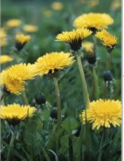Alternatives to Pesticides
Why Use Alternatives?
Pesticides are among the most widely-used chemicals in the world, but are also among the most hazardous to human health, sometimes causing serious acute and chronic health effects.
When used by trained professionals as part of an Integrated Pest Management Plan, pesticides can still be a valuable tool in managing noxious weeds or other invasive organisms to protect infrastructure, ecosystems and human health.
Pesticides include insecticides, herbicides, and fungicides. Although these products are designed to kill insects, weeds, and fungi, there is no guarantee that they can fully get rid of these pests. In fact, by using pesticides, insects that are beneficial to the garden ecosystem may also be destroyed.
It's easy to grow a beautiful and nautral lawn and garden without the use of chemicals. It all starts with healthy soil! Click here for tips.
Alternatives to cosmetic pesticides are generally more appropriate and less harmful to humans and the environment in the long run. Such alternatives often involve implementing better gardening strategies that solve pest problems in a natural, long-lasting way. Alternatives are also less harmful to the applicator and other people in the area. Making a difference in the environment can begin in our own backyards!
In BC, low risk pesticides are known as “Excluded Pesticides” under Schedule 2 of BC’s Integrated Pest Management (IPM) Act and include:
- acetic acid
- asphalt solids (pruning paints)
- bacillus thuringiensis kurstaki (Btk)
- boron compounds boron compounds with up to 5% copper for insect control and wood preservation
- capsaicin
- corn gluten meal
- ferric phosphate
- ferrous sulphate
- insect pheromones
- methoprene
- mineral oils for insect and mite control
- pyrethrins silicon dioxide, aka "diatomaceous earth"
Some BC bylaws refer to these low risk products as “Permitted Pesticides” as their use is allowed or “permitted”.
Manually pulling weeds, digging them up and letting them dry in the sun before adding them to a mulch pile or compost may be the most environmentally friendly way to get rid of weeds. More weed specific control methods are listed below.
Government Information
- The Ministry of Agriculture, provides extensive information for ranchers, farmers, growers, crop consultants, pest managers, and horticulturalists about the safe use of pesticides in BC.
- The Pest Management Regulatory Agency (PMRA) main page, an agency in Health Canada that regulates pesticides
- The label search page, where all the registered pesticide labels in Canada can be found
Alternatives for Treating Common Pests
If the pest you are looking for is not found below, try one of these links for more information on pests and alternatives to pesticides:
- PMRA's pest notes
- BC Ministry of Agriculture's factsheets
- Pest Control Canada's pest factsheets
***It is NOT a good idea to make your own pesticides at home.***
Alternatives Index:
Ants
Aphids
Houseflies
Mosquitoes
Rats
Slugs and Snails
Spiders
White Pine Weevils
Yellowjackets
Alternatives to Treating Common Weeds
Blackberry
Regular mechanical mowing. Planting a perennial, such as grass, will help by providing competition for new seedlings. For more informaiton, read Nonchemical Methods for Removing Unwanted Blackberry Plants
Crabgrass

Mulch in gardens, overseed and raise mover blades on lawn. Pull established crabgrass by hand and/or cut before they go to seed.
Clover

Clover is good for your lawn and provides nitrogen.
Dandelions

Mulch in gardens, overseed and raise mover blades on lawn. Pull established dandelions by hand and/or cut before they go to seed. For more information, read Dealing with Dandelions.
Moss

Dig out and aerate lawn, maintain a healthy lawn through green yard care techniques.
Weeds in interlocking blocks/patio

Pull out by hand and/or pour boiling water over
| Attachments | |||
| Description | Date | File Size | |
| Preventing and cleaning up after rodents | 2020-07-21 | 218KB | |
